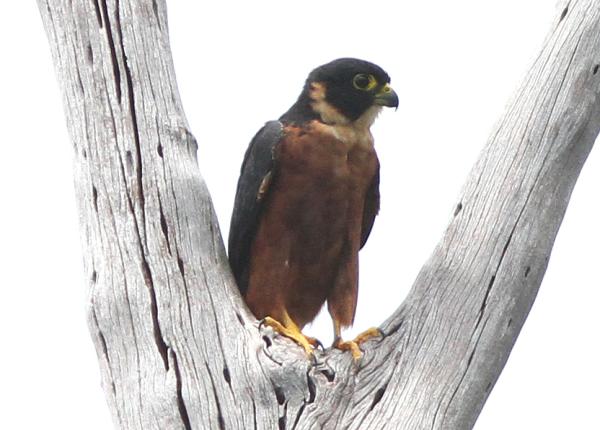Did You Know?
- This species is also known as the Burmese Hobby and the Indian Hobby.
- The Oriental Hobby hunts most frequently at dawn and at dusk
How The Peregrine Fund is Helping
Though The Peregrine Fund does not work directly with Oriental Hobbies, our efforts in scientific research, habitat conservation, education, and community development help conserve birds of prey worldwide. We also supply literature to researchers from our avian research library, which helps scientists around the world gather and share important information on raptor conservation. And, finally, our support of the Global Raptor Information Network gives raptor researchers tools to more efficiently conduct their own studies while contributing to a global program. It also provides citizen scientists a way to participate in raptor science and conservation.
Where They Live
Found throughout parts of Asia including the Indian Subcontinent, Nepal, Thailand, the Philippines, ,Sulawesi, New Guinea, it makes its home in forest edges, clearings, secondary growth, native gardens, mangroves, grasslands, and plantations.
What They Do
If you ever find yourself in Oriental Hobby habitat, be sure to scan any exposed perches you might find. The Oriental Hobby conspicuously in dead trees. Though it usually is found by itself, it can sometimes be seen in pairs or in small family groups.
Oriental Hobby populations that live in the Himalayas are migratory, traveling to southern parts of India for winter.
Why They Need our Help
This species is categorized as Least Concern, and scientists estimate between 1000–10,000 individuals exist. However, However, populations are likely declining mostly due to habitat loss as a result of deforestation.
What They Eat
This falcon has a varied diet. It feeds on small birds, bats, and insects. It will also actively hunt dragonflies over open water. When on the hunt, it often sits on a perch, waiting and watching, before flying after its prey in quick pursuit, catching prey in air.
Nests, Eggs, and Young
The Eurasian Hobby doesn't build its own nest. Instead, it lays its eggs in holes in trees or in the old nest of another species. The female will lay 2-4 eggs. Once the eggs are laid, both the male and female will help incubate for the next 28–30 days. After the young hatch, they will grow quickly. After only around 30 days of age, they will be ready to fly from the nest for the first time.
Oriental Hobby and the World Center for Birds of Prey
Though The World Center for Birds of Prey is quite far from the Oriental Hobby's range, it is still a wonderful place to learn about birds of prey, and even other falcon species! Come to the World Center for Birds of Prey and meet an American Kestrel up close, examine kestrel feathers at the touch table, and compare the size of a kestrel egg with that of an ostrich. If you walk the interpretive nature trail to the gazebo overlooking the Boise Valley, you are likely to see a kestrel hovering over the sage in search of prey or, if you are lucky, a young bird just learning to fly.
References:
Clark, W. S., P. F. D. Boesman, and J. S. Marks (2020). Oriental Hobby (Falco severus), version 1.0. In Birds of the World (J. del Hoyo, A. Elliott, J. Sargatal, D. A. Christie, and E. de Juana, Editors). Cornell Lab of Ornithology, Ithaca, NY, USA. https://doi.org/10.2173/bow.orihob1.01
Global Raptor Information Network. 2023. Species account: Oriental Hobby Falco severus. Downloaded from http://www.globalraptors.org on 2 Jan. 2023










